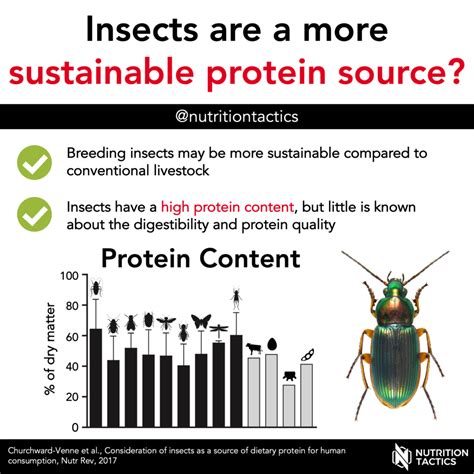VS. Traditional Protein Sources
In the face of increasing global food demand and sustainability concerns, insect protein has emerged as a promising alternative to traditional protein sources like livestock and plants. With its high nutritional value, environmental friendliness, and potential for scalability, insect protein holds enormous potential for revolutionizing biotechnology in the years to come.

The Rise of Insect Protein
According to the United Nations, the world’s population is projected to reach 9.7 billion by 2050, leading to a significant increase in demand for protein. Traditional protein sources, such as meat and dairy, are associated with high environmental impacts, including greenhouse gas emissions, deforestation, and water consumption.
Insect protein, on the other hand, offers a sustainable and efficient solution. Insects are highly efficient at converting feed into protein, requiring only a fraction of the land, water, and energy needed for livestock production. Moreover, they produce significantly fewer greenhouse gas emissions.
Nutritional Value and Versatility
Insect protein is an excellent source of essential amino acids, minerals, and vitamins. Compared to plant proteins, insect proteins are generally more digestible and have a higher absorption rate. This makes them particularly valuable for individuals with dietary restrictions or nutrient deficiencies.
In addition, insect protein is remarkably versatile. It can be processed into various forms, including flours, powders, and concentrates. These products can be incorporated into a wide range of food products, from protein bars and shakes to baked goods and pasta.
Environmental Benefits
The environmental benefits of insect protein production are substantial. Insects require significantly less land, water, and energy than traditional livestock. They also produce far fewer greenhouse gas emissions, contributing to climate change mitigation.
Moreover, insect farming can reduce the environmental impact of livestock waste. By converting organic waste into protein, insects help to reduce methane and ammonia emissions associated with traditional animal agriculture.
Economic Potential
The economic potential of insect protein is enormous. The global insect protein market is projected to reach $4.1 billion by 2025, driven by the growing demand for sustainable protein sources.
Insect farming can also create new job opportunities in rural areas. Large-scale insect production facilities require skilled labor and research and development professionals.
Challenges and Opportunities
Despite its potential, insect protein faces several challenges that need to be addressed for widespread adoption. These challenges include consumer acceptance, regulatory hurdles, and scalability.
Consumer acceptance is a crucial factor for the success of insect protein products. Addressing societal perceptions and promoting the nutritional and environmental benefits of insect protein is essential for fostering consumer trust.
Regulatory frameworks for insect protein production and consumption vary widely across jurisdictions. Establishing clear and harmonized regulations is necessary to ensure consumer safety and promote the development of the industry.
Scalability is another important aspect for insect protein to meet the increasing global demand. Developing efficient production systems, optimizing feed conversion ratios, and improving processing technologies are key to achieving cost-effective and sustainable production.
Innovative Applications
Beyond traditional food applications, insect protein has the potential for a wide range of innovative uses in biotechnology. These include:
- Bioplastics: Insect protein can be used as a renewable and biodegradable alternative to petroleum-based plastics.
- Cosmetics: Insect proteins have antioxidant and anti-inflammatory properties, making them valuable ingredients in skincare and haircare products.
- Pharmaceuticals: Insect proteins can be modified and engineered for specific therapeutic applications, such as drug delivery and wound healing.
Conclusion
Insect protein holds immense promise for the future of biotechnology. Its nutritional value, environmental advantages, and economic potential make it a compelling alternative to traditional protein sources.
Overcoming challenges related to consumer acceptance, regulatory frameworks, and scalability will be crucial for the widespread adoption of insect protein. With continued research and innovation, insect protein has the potential to revolutionize the biotechnology industry and contribute to a more sustainable and food-secure future.
Tables
| Characteristic | Insect Protein | Traditional Protein Sources |
|---|---|---|
| Protein Content | 60-80% | 20-40% |
| Amino Acid Profile | Excellent, high in essential amino acids | Incomplete, often deficient in essential amino acids |
| Environmental Impact | Low land, water, and energy requirements | High land, water, and energy requirements |
| Greenhouse Gas Emissions | Significantly lower | Higher |
| Nutritional Value | High in protein, minerals, and vitamins | Variable, often lower nutrient content |
| Versatility | Can be processed into various forms | Limited processing options |
| Industry Outlook | Metric | Value |
|---|---|---|
| Global Insect Protein Market Size (2023) | Market Value | $1.4 billion |
| Projected Global Insect Protein Market Size (2025) | Market Value | $4.1 billion |
| Projected Annual Growth Rate (2023-2025) | CAGR | 29.2% |
| Major Market Drivers | Growing demand for sustainable protein sources, increasing consumer awareness |
| Strategies for Overcoming Challenges | Challenge | Strategy |
|---|---|---|
| Consumer Acceptance | Address societal perceptions, promote nutritional and environmental benefits | |
| Regulatory Hurdles | Establish clear and harmonized regulations, provide consumer safety assurance | |
| Scalability | Develop efficient production systems, optimize feed conversion ratios, improve processing technologies |
| Highlights | Feature | Benefit |
|---|---|---|
| Nutritional Value | High protein content, complete amino acid profile | Supports muscle growth and repair, promotes overall health |
| Environmental Sustainability | Low land, water, and energy requirements | Reduces greenhouse gas emissions, promotes climate change mitigation |
| Economic Potential | Growing market demand, job creation opportunities | Provides new revenue streams, contributes to rural development |
| Versatility | Can be processed into various forms | Enables integration into a wide range of food and non-food products |
| Innovative Applications | Bioplastics, cosmetics, pharmaceuticals | Expands the potential of insect protein, creates new industries |





















